Mushrooms are an interesting and unique organism found in many different forms throughout nature.
The color purple is often associated with royalty, mystery, and excitement, so the combination of these two ideas is truly captivating.
For those interested in learning more about the fascinating world of purple mushrooms, this article will explore some of the characteristics that make them so special.
From what they look like to their potential uses, you will come away with a greater understanding and appreciation for this mysterious fungi.
List of Purple Mushrooms
It is important to be cautious when identifying and consuming wild mushrooms, as some species can be poisonous. If you are unsure whether a mushroom is safe to eat, it is best to err on the side of caution and not consume it.
1. Wood Blewit
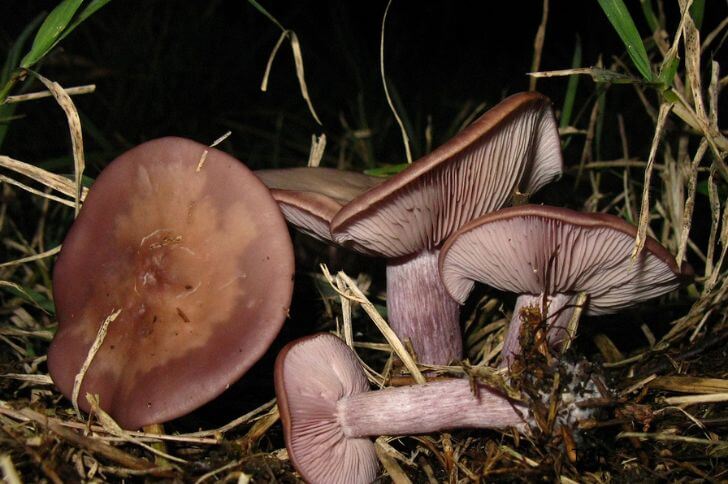
Wood blewits are the most common types of purple mushrooms and are commonly found in wooded areas. They have a distinctive appearance and can be identified by:
Identification:
Also called clitocybe nuda, this purple colored fungi has a 1-4 inch convex cap with inward curved edges. The surface of the cap is usually a dark purplish-brown color. Next, check the underside. Wood blewit’s gills are broad and close together, and they are usually a pale lilac or lavender color.
Another way to identify this blewit is by checking its stem. It grows to about 4 inches tall and usually a pale lilac or lavender color. It also has a swollen base. Lastly, do a spore print test. Wood blewits have a pinkish spore print.
Spore print: The spore print of a wood blewit is dark purplish-brown. How can you prepare clitocybe nuda? You can fry or add to stews. Some foragers also use them in lamb dishes.
2. Violet Webcap
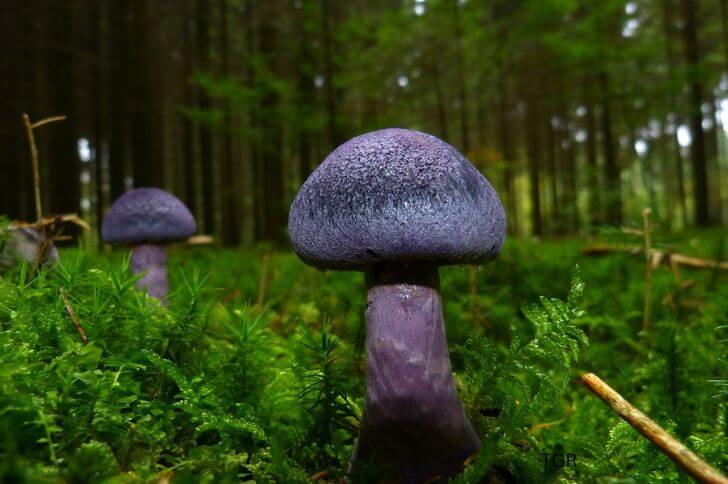
Closely related to blood red webcaps, violet webcaps are a type of purple fungi that prefers conifer forests in North America. It is also common in Europe.
Identification:
With inrolled margins, violet webcaps have 1-3 inches caps. Younger species are dark purple and become lighter with age. Note, unlike other webcaps, violet webcaps are not slimy. As for gills, this purple mushroom has well-spaced gills that are purple in young specimens and brownish for older specimens.
Stems and flesh are also purple. I would recommend if you come across this species, take a few photos but do not pick them. Webcaps are inedible but their beauty is unmatched.
3. Primrose Brittlegill
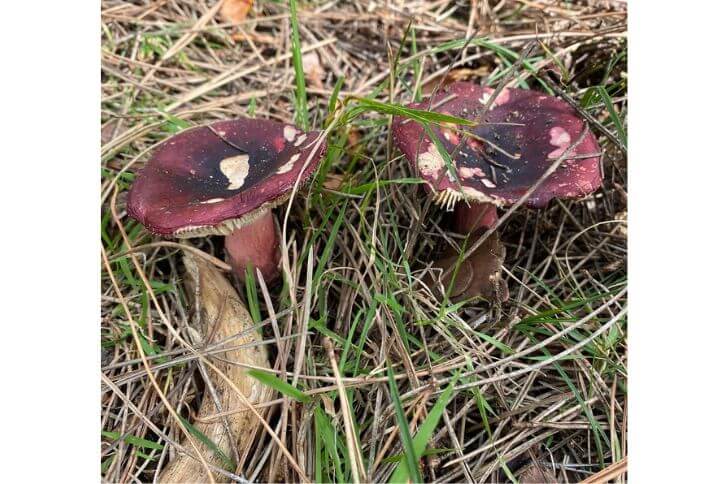
Primrose Brittlegill mushrooms are a common purple fungus that grows on sandy soils in pine forests. It is native to Britain and much of Northern Europe.
Identification:
There are three sure ways to identify a primrose brittlegill. One, they are recognizable by their distinctive fruity smell. Two, check the fruiting body. These brittle gills have a cap that is 1-4 inches wide and a stem that can range from 2-5 inches long. The caps are reddish purple with a darker middle.
The gills on the underneath side of the cap vary from light yellow to lemon in hue, turning golden yellow in maturity.
Can you eat these brittlegills? These are what you’d call survival mushrooms. You don’t eat them until you are all out of other edible mushrooms. Primrose brittlegills are ‘pepper hot.’
4. Purple spored puffball
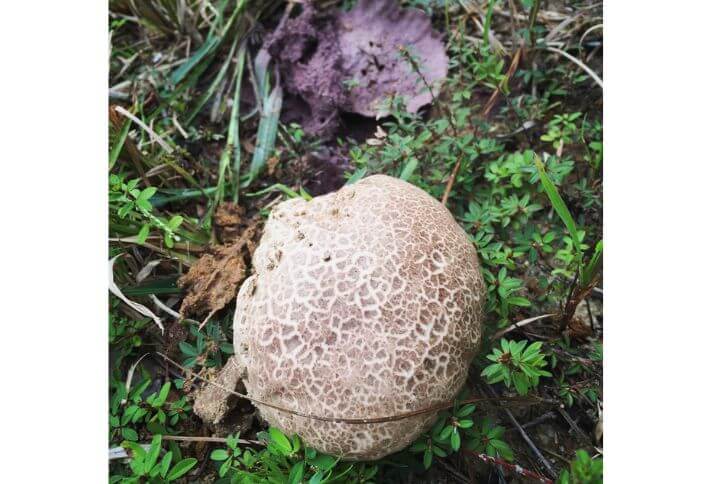
For mushroom enthusiasts, the purple spored puffball mushroom is an interesting find. While not all areas have this species of mushroom, those that do are able to enjoy its unique shape and size.
Identification:
Scientifically known as Calvatia cyathiformis, it is a member of the agaricaceae family. Though ‘cyathiformis’ means flask, this large purple mushroom has a round ball-like shape.
The exterior of these mushrooms are a smooth brownish color, but as they age they eventually turn grey. The inner layers or flesh are whitish for younger puffballs turning brownish purple in maturity. No distinctive smell.
These purple mushrooms can range anywhere from 2-8 inches in diameter depending on where it is located geographically.
5. Purple Brittlegill Mushrooms
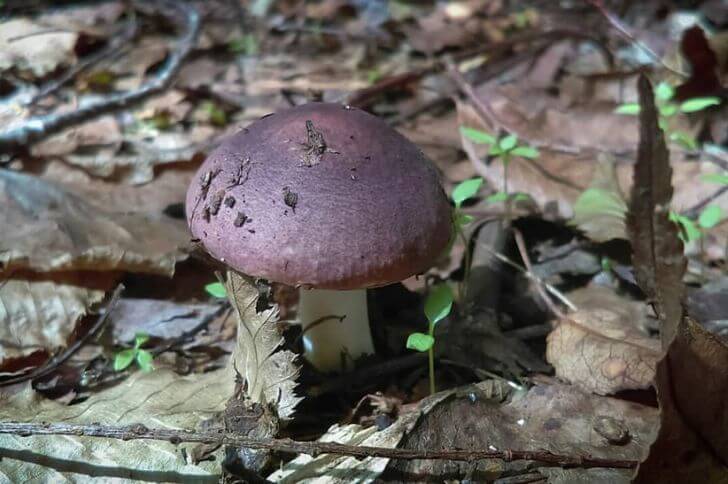
Russula atropurpurea, most foragers know them as purple brittlegill mushrooms or blackish purple russulas are summer-autumn mushrooms of eastern North America. They also occur in Europe.
Identification:
This type of purple fungi is easily identified by its distinguishing characteristics, such as its red purple cap with an almost black center.
Underneath the first layer you’ll find white flesh with a subtle scent reminiscent of apples. Note the cap starts out flat becoming slightly depressed as the brittlegill ages.
Additionally, the crowded, pale cream gills underneath the cap of the mushroom are an important indicator to identify this species from other types of mushrooms.
Where can you find purple brittlegill? Check under pines or beeches.Like the primrose brittlegill they are known for their hot peppery taste.
6. Purplepore Bracket
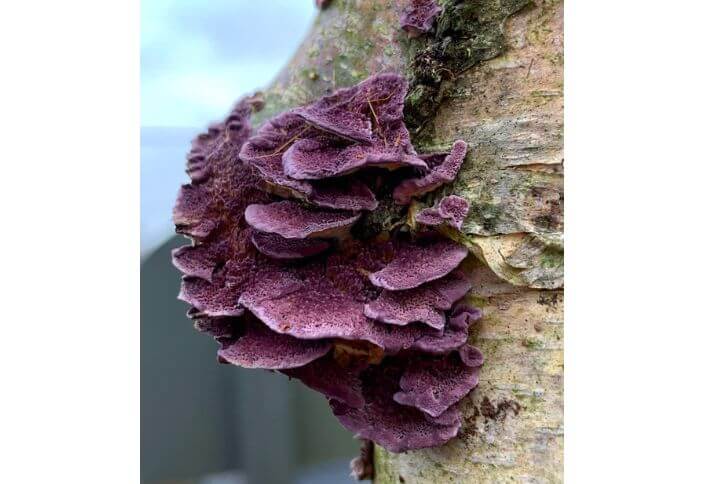
Purplepore bracket, also known as the trichaptum abietinum, is a type of fungi that belongs to the family incertae sedis.
Identification:
It is a medium to large, fan-shaped mushroom that grows on dead conifer wood. This fungus has a purplish gray outer surface. The surface can be hairy or dry. You can find this bracket fungi throughout the year and its flesh is inedible.
Related Read: Common Indiana mushrooms
7. Purple Jellydisc Mushrooms
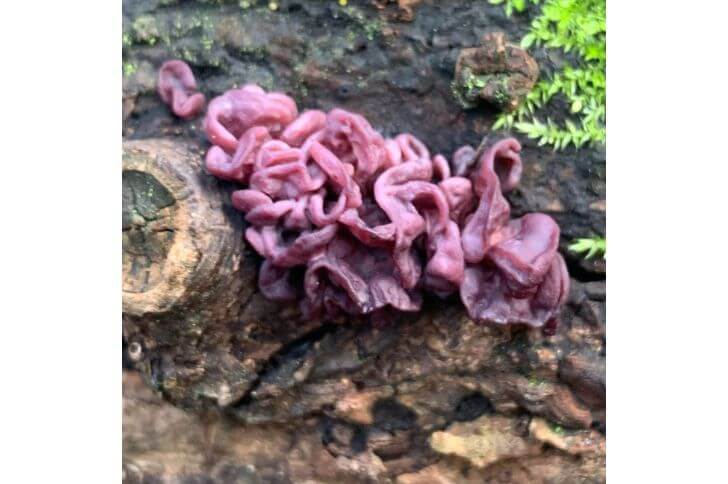
Another type of fungi you may come across is the purple jellydisc. It is a wood-rotting fungus often found on dead beech stumps and branches.
Identification:
These mushrooms get their name from their appearance, as they have a jelly-like texture and a purple hue. A young fruiting body is round with a smooth surface.
As it ages, the middle part sinks in. And, because they grow in clusters, the overall shape of the cluster looks like a giant brain.
Also referred to as jelly drops, this purple fungi is inedible.
8. Purple Edge Bonnet Mushrooms
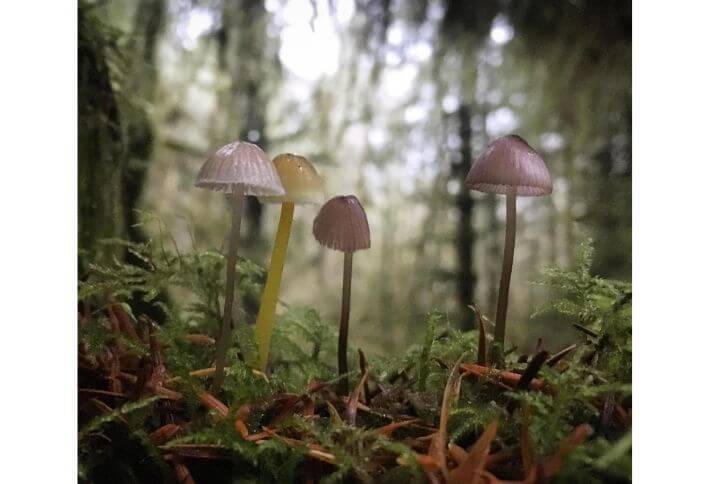
I think the purple edge bonnet is one of the hardest mushrooms to identify. Fruiting bodies come in three different colors which may throw off even seasoned foragers.
Identification:
Purple edge bonnets come in pure white, yellow, or purple forms. For this article we’ll look at the purple fruiting body.
The cap has a lilac hue near its edges which becomes darker toward the center. In contrast to this, the gills on the underside of the cap have a pale gray color.
Additionally, this purple mushroom features a thin stalk with no ring or volva at its base making it easy to distinguish from other species.
9. Violet Cup Fungus
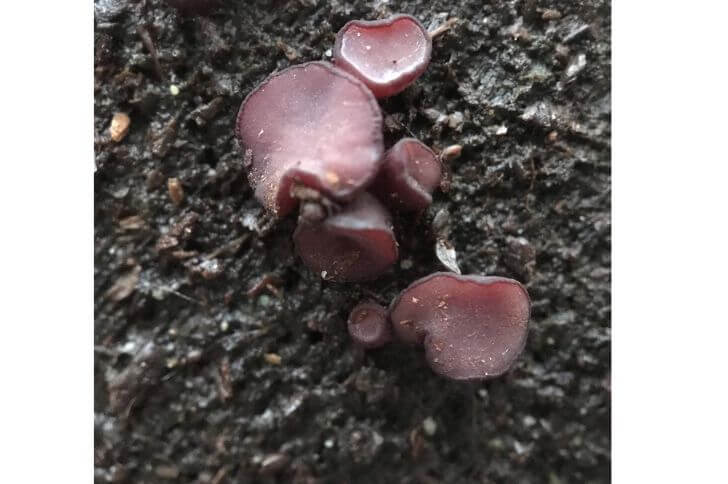
The violet cup fungus, scientific name Peziza violacea, is an easily-recognizable mushroom on paper but you may miss it when foraging due to its dull coloring.
Identification:
Cup fungi have a unique shape and this violet fungi is no exception. This mushroom’s fruiting body starts out spherical and as it matures, the center gets sucked inward, giving it the cup shaped body. In its final days the fungi will be almost flat. Its flesh is thin and purplish.
Violet cup fungus typically grow in small clusters but their dull purple color makes it hard to spot them. You need to pay close attention to find them.
Also read: Kentucky mushrooms
10. Violet Coral
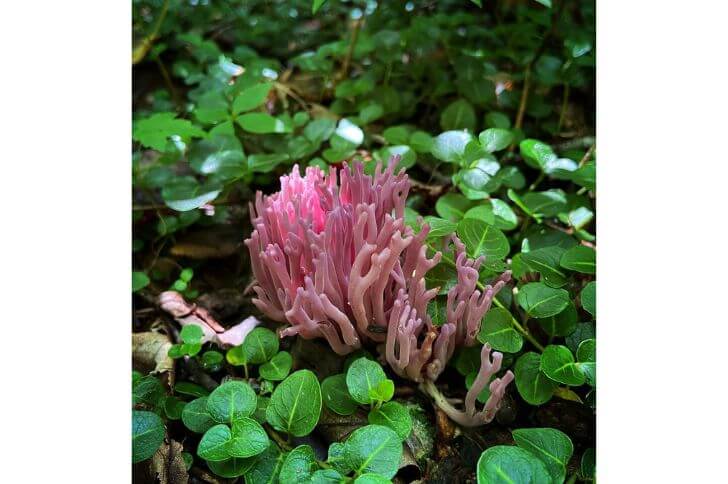
Violet coral mushroom identification is essential for those looking to explore the outdoors and observe nature in its fullest form.
Identification:
Scientifically called Clavaria zollingeri and also known as magenta coral, this purple mushroom is stunning. This small mushroom looks like a flower.
Violet coral has a particularly eye-catching appearance; the vibrant purple coloration combined with its intricate branching structure make it easy to identify from other mushrooms.
The finger-like branches generally grow to around four inches tall. This coral grows singly but can also be found in clusters.
11. Cortinarius Iodes
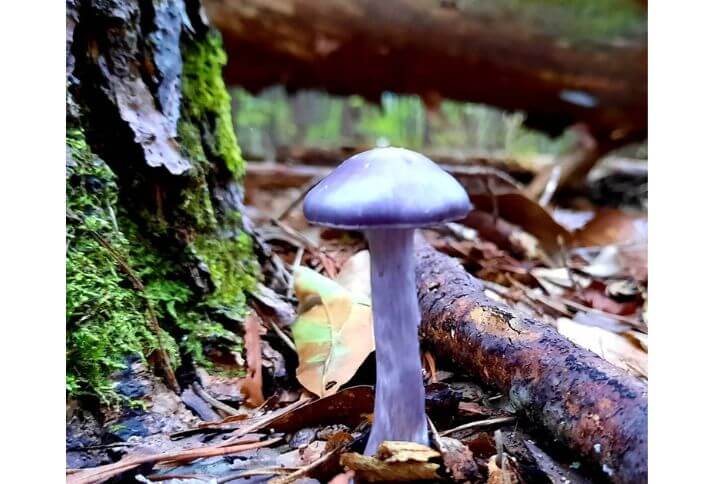
Colloquially known as viscid violet cort or you may know it as spotted cort, the cortinarius iodes is a slimy purple mushroom that grows singly.
Identification:
The cap can range from convex to bell-shaped with a viscid surface that darkens when wet. The gills are usually dull lilac and attached to its stem. Doesn’t smell and doesn’t taste good.
12. Laccaria Amethysteo-occidentalis
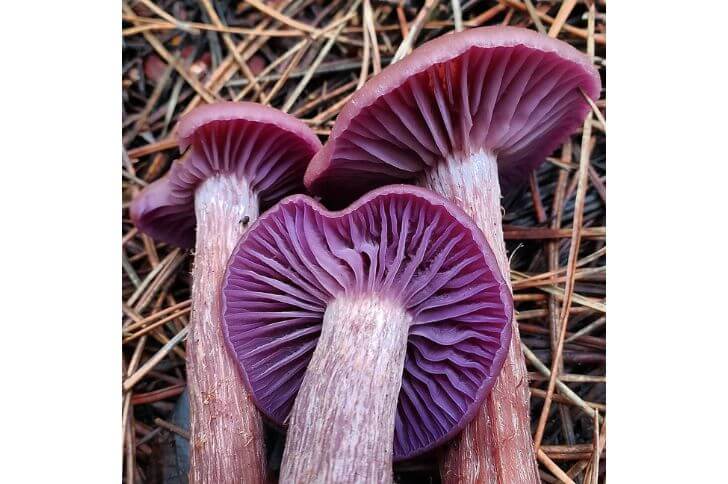
Laccaria amethysteo-occidentalis is an often overlooked mushroom species native to western North America. It can be found in shady areas, under pines. This purple species of mushroom has a distinct appearance that makes it easily identifiable.
Identification:
The cap of this mushroom ranges from .5-3 inches wide and is a vibrant purple color. The gills underneath are grayish purple and attached to the thick stem. Its stem is long with a short bulbous base. The stem’s exterior surface is covered in tiny hairs.
FAQs
Is purple laccaria edible?
In the genus laccaria, the Laccaria ochropurpurea and Laccaria amethysteo-occidentalis are edible. Most other purple mushrooms in this genus are inedible.
Is violet webcap edible?
The violet webcap or violet cort is bitter and inedible. Most foragers like it for its beauty only.
Is the amethyst mushroom real?
Yes. Also a member of the laccaria genus, the amethyst deceiver or Laccaria amethystina is a small purple mushroom that grows from summer to winter.
Sources:
Laccaria amehysteo occidentalis
Hi There,
My name is Jenny. I’m the Chief Editor at Try Green Recipes and besides making yummy and healthy foods for my kids, grandkids, and friends. I’m new to the blogging world but I believe what I have to share is unique and will bring joy to your home. If you are adventurous and want try something tasty, let’s get started.

